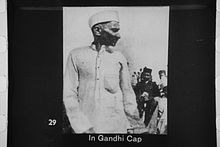Gandhi cap

The Gandhi cap (Hindi: गांधी टोपी) is a white sidecap, pointed in front and back and having a wide band. It is made out of khadi. It takes its name after the Indian leader Mahatma Gandhi, who first popularised its use during the Indian independence movement. Worn commonly by Indian independence activists, it became a symbolic tradition for politicians and political activists to wear it in independent India.
Genesis[]

The Gandhi cap emerged in India during the Non-cooperation movement from 1920–22.[1] when it became the standard Congress dress as popularized by Gandhi. In 1921, the British government tried to ban the use of the Gandhi cap. Gandhi himself wore the cap only for one or two years during 1920–21.[2][3]
Gandhi's homespun khadi attire of traditional Indian clothes were symbolic of his message of cultural pride, the use of Swadeshi goods (as opposed to those manufactured in Europe), self-reliance and solidarity with India's rural masses. The cap became common to most followers of Gandhi and members of the Indian National Congress. A connection to the independence movement was implied when any individual wore the cap in those times.
Prisoners in South African prisons classified as "negroes" (a category into which Indians fell while Gandhi was in South Africa) also were required to wear similar caps in prison during 1907 to 1914. Gandhi's close friend Henry Polak cites Gandhi's time in South African jail, where he was classified as a "negro" and thus required to wear such a cap, as the genesis of the Gandhi Cap.[4]

However Gandhi, in a letter to Kaka Kalelkar, described in detail how he based his white cap on the Kashmiri cap.[5]
After independence[]
The first generation of post-independence Indian politicians were almost universally members of the freedom struggle. Assassination of Mahatma Gandhi gave an emotional importance to the Gandhi cap, which was regularly worn by Indian leaders like Jawaharlal Nehru, India's first Prime Minister. Succeeding prime ministers such as Lal Bahadur Shastri and Morarji Desai would continue the tradition. Most members of the Indian Parliament (especially politicians and activists of the Congress party) wore khadi clothing and the Gandhi cap. Large numbers of people donned the cap while celebrating India's independence on August 15 or the promulgation of a republic on January 26.
Jawarharlal Nehru was always remembered as having worn the cap. In 1964 a coin showing Nehru in profile was released which was widely criticized for lacking the cap. Another Nehru coin was later released in 1989 on his birth centenary, which showed him wearing a cap.
In later times, the cap had lost its popular and political appeal. Although many members of the Congress party continued the tradition, rival political parties preferred to dissociate themselves from the tradition linked with the Congress. The mass acceptance of Western-style clothing had also diminished the importance of wearing Indian-style clothes for politicians.

The cap remains the most popular everyday headgear worn by men in rural parts of Maharashtra.[6]

In the "I Have a Dream" speech of Martin Luther King Jr. in 1963, many people standing behind him on stage wore Gandhi caps.[7]
Re-emergence[]
In 2011, the Gandhi cap once again rose in popularity in India after Anna Hazare, an eminent Gandhian from Maharashtra, started an anti-corruption movement in India. The epicenter of this movement was in Delhi. In August 2011, thousands of people wearing Gandhi caps accumulated at Ramlila Maidan in Delhi to support Anna Hazare on his fast-unto-death. This movement spilled over to many other parts of the country and stadiums, community centers and grounds were booked for assimilation of a similar nature. The mass movement witnessed people of all age groups, religions and social standings (mainly the middle class) as participants, many among them shouting slogans and wearing Gandhi caps.
In the 2014 election, the workers of Aam Aadmi Party widely wore the Gandhi cap with text printed on it.[8][9] Supporters of the Bharatiya Janata Party wore a similar saffron colored cap.[10]

See also[]
- Indian National Congress
- Pagri (turban)
- Peshawari pagri
- Taqiyah
- Songkok
- Dutch cap
- Cap of Maintenance
References[]
- ^ Consumption: The history and regional development of consumption edited by Daniel Miller, p. 424
- ^ Kothari, Urvish (18 September 2011). "ગાંધીટોપીઃ મારોય એક જમાનો હતો..." urvishkothari-gujarati.blogspot.com. Retrieved 8 April 2018.
- ^ Gandhi was photographed wearing a turban or a round black topi in 1915 and 1918. He was photographed with the Gandhi cap in 1920. see 1915-1932 Mahatma Gandhi Photo Gallery http://www.mkgandhi.org/gphotgallery/1915-1932/index1.htm, Mahatma Gandhi, 1915 - 1920, Page 7 http://www.gandhimedia.org/cgi-bin/gm/gm.cgi?direct=Images/Photographs/Personalities/Mahatma_Gandhi/1915_-_1920&img=90. By 1924 he had given up wearing a kurta and the cap. Also see http://www.columbia.edu/itc/mealac/pritchett/00routesdata/1900_1999/gandhi/gandhigods/gandhigods.html
- ^ H.S.L Polak Mahatma Gandhi (London: Odham's Press, 1949) pg. 61
- ^ Clothing Matters: Dress and Identity in India, Emma Tarlo,University of Chicago Press, Sep 1, 1996.82-83
- ^ Bhanu, B.V (2004). People of India: Maharashtra, Part 2. Mumbai: Popular Prakashan. pp. 1033, 1037, 1039. ISBN 81-7991-101-2.
- ^ Tharoor, Kanishk (2018-04-04). "The Debt MLK Owed to India's Anti-Colonial Fight". The Atlantic. Retrieved 2020-02-13.
- ^ "बहुरंगी हुई गांधी की टोपी". jagran.com. Retrieved 8 April 2018.
- ^ Whitehead, Andrew (28 April 2014). "How India's iconic Gandhi cap has changed sides". Retrieved 8 April 2018 – via www.bbc.com.
- ^ Bhattacharjee, Sumit (24 April 2014). "Gandhi cap changes colours!". Retrieved 8 April 2018 – via www.thehindu.com.
- Katherine Frank, Indira: The Life of Indira Nehru Gandhi (2002)[page needed]
- Rajmohan Gandhi, Patel: A Life (1992)[page needed]
External links[]
| Wikimedia Commons has media related to Gandhi caps. |
- Mahatma Gandhi
- Indian independence movement
- Indian clothing
- Hats
- Caps
- Indian headgear